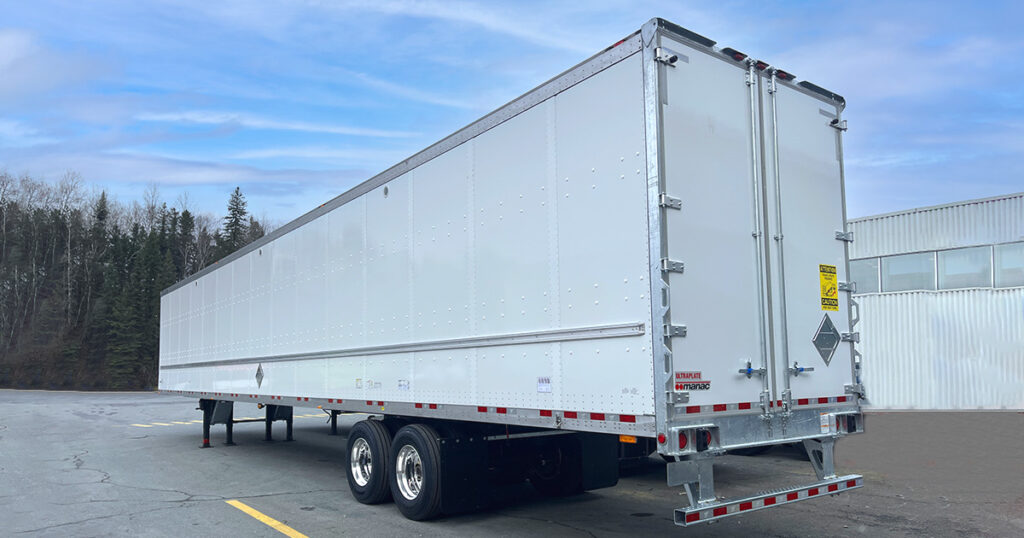60-foot trailers authorized in Quebec, with special permit
The pilot testing phase is over, 60-foot trailers are now authorized to operate in Quebec, on certain roads and under certain conditions, such as obtaining a special permit.
This was announced by the Ministry of Transport and Sustainable Mobility (MTMD), specifying that these extended trailers (18.45 meters) can be coupled to a tractor on divided highways and their lanes, exit and entry routes, road segments that connect the exit or entry lanes of a highway in reverse directions as well as access roads to a municipal industrial park from an exit or entry lane highway and over a distance of no more than two kilometers.
Roads not previously covered can also be used from a highway exit or entrance lane and over a distance of no more than 500 meters, as well as roads within a municipal industrial park.
Benefits
The 60-foot, 6-inch semi-trailers have several advantages over the 53-foot semi-trailers that are the norm.
On a productivity level, one driver can transport more goods with a single power unit, helping to reduce the pressure caused by the labor shortage.

According to Manac’s calculations, a 60-foot van offers 560 cubic feet more than its 53-foot equivalent.
Transporting more freight in a single movement is also an environmental advantage since fewer trucks on the road emit less greenhouse gases (GHG).
On the other hand, they are an interesting alternative to long combination vehicles (two 53-foot trailers coupled to a tractor) since the drivers who tow 60-footers are not subject to the same specialized training requirements as those who are behind the wheel of LCVs.
Finally, they are ideal for competing with carriers in the Maritimes, where they have already been permitted for some time, New Brunswick having been the last Atlantic province to authorize them, last May.
Ontario may soon follow the example of its eastern neighbors, since its pilot projects were closely linked to those of Quebec.
Supply chain
It will probably take some time before these “jumbo” trailers are common, so that a suitable supply chain can be put in place allowing manufacturers to build them.
Even if manufacturers like Manac and Utility already have prototypes in circulation, the transition from 53 to 60 feet is not without challenges for manufacturers.
“Extruders, mainly in North America, make products of 53, 57 feet and not 60. So there are certain engineering challenges that had to be resolved to ensure complete integrity on the 60 feet,” explains Rodrick Levesque, vice-president of engineering at Manac in an interview with Transport Routier.
And several trailer manufacturers are already unable to meet existing demand for 53-foot vans and have production backlogs for them. They will need time to adjust their manufacturing and tooling methods to move on to 60-foot trailers.
According to Manac, the typical customer for these new type of trailers will be companies wishing to transport products with a high volume but a limited weight, for example potato chips.
Have your say
This is a moderated forum. Comments will no longer be published unless they are accompanied by a first and last name and a verifiable email address. (Today's Trucking will not publish or share the email address.) Profane language and content deemed to be libelous, racist, or threatening in nature will not be published under any circumstances.
longer trailers yeah what is with these people the roads are in miserable shape and yet they want to load heavier what about when you get in town turning these horses made for roads ?? what do you do?? take the side of the road out signals and all.
What about a pay increase for drivers?
Perhaps they should use automated trucks and leave drivers safe doing other sorts of driving.
My concern with this is in bad weather. A 7 foot increase in length equals about 65 square feet give or take of more trailer to catch side winds in bad weather. Then when these barns on wheels get blown over it equals more insurance costs, more negative media news coverage, negative views in the public’s eyes, and probably other things. There are drivers who can barely handle what is on the road now, can’t figure out about tail swing, and companies want bigger trailers still?
Bad enough trying to get into some older facilities built in the 30s to 60s with a 53 foot trailer as it is.
This should be a lot more fun now.
This is a very bad idea a better solution is 3 32 foot trailers as a b train.